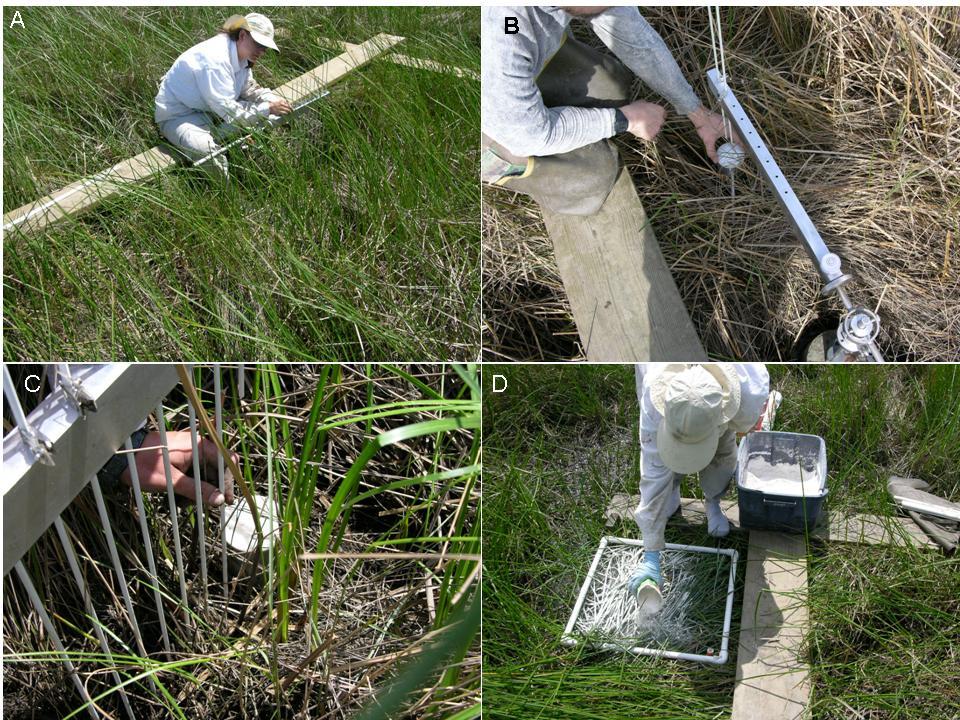
Julia A. Cherry
she/her/hersProfessor
Joint Appointment, New College
- julia.cherry@ua.edu
- (205) 348-8416
- 1030 Bevill Building
- Website
- Not Accepting Students
Education
- Postdoctoral Research, United States Geological Survey
- PhD, Biological Sciences, The University of Alabama, 2005
Research Interests
My research is aimed at understanding the various mechanisms influencing the structure and function of wetland ecosystems. The majority of my research is focused on responses of Gulf of Mexico tidal marshes to global environmental changes, including climate change and nutrient enrichment. I also work closer to campus in freshwater wetlands near Tuscaloosa.
 Figure 1. Measurement of surface elevation and vertical accretion in coastal marshes – (A) access platform for measurement of elevation change, (B) Rod Surface Elevation Table (rSET) used to determine elevation change, (C) close-up of pins lowered to marsh surface, and (D) feldspar marker horizons applied to marsh surface to measure vertical accretion.[/caption]
Figure 1. Measurement of surface elevation and vertical accretion in coastal marshes – (A) access platform for measurement of elevation change, (B) Rod Surface Elevation Table (rSET) used to determine elevation change, (C) close-up of pins lowered to marsh surface, and (D) feldspar marker horizons applied to marsh surface to measure vertical accretion.[/caption]
Global Change Effects on Tidal Wetlands
The goal of our coastal wetland research program is to understand the ways in which tidal marshes can keep pace with sea-level rise through biological feedbacks to marsh surface elevation. In particular, we examine how simultaneously changing external forcing factors, such as elevated CO2, sea-level rise, nutrient enrichment, storm sedimentation, or fire, affect marsh processes that regulate organic matter accumulation, vertical accretion, or the capacity for upslope migration. We combine greenhouse and field studies to (1) identify biophysical processes regulating marsh surface elevations; (2) examine impacts of disturbance or restoration on marsh structure and function; and (3) help develop models that inform adaptive management and restoration strategies.Population and Community Dynamics in Temperate Freshwater Wetlands
To a lesser extent, we conduct research in local freshwater wetlands with the goal of understanding how plant communities respond to changes in their environment, interact with each other, and influence ecosystem processes. This work includes investigation of plant responses to invertebrate grazing, to competition with other plant species, and to water level fluctuations. We have examined how changes in community composition and liter quality influence patterns of nutrient or material export from beaver-formed wetlands embedded within larger stream networks. [caption id="attachment_7912" align="alignnone" width="640"] Figure 1. Measurement of surface elevation and vertical accretion in coastal marshes – (A) access platform for measurement of elevation change, (B) Rod Surface Elevation Table (rSET) used to determine elevation change, (C) close-up of pins lowered to marsh surface, and (D) feldspar marker horizons applied to marsh surface to measure vertical accretion.[/caption]
Figure 1. Measurement of surface elevation and vertical accretion in coastal marshes – (A) access platform for measurement of elevation change, (B) Rod Surface Elevation Table (rSET) used to determine elevation change, (C) close-up of pins lowered to marsh surface, and (D) feldspar marker horizons applied to marsh surface to measure vertical accretion.[/caption] Selected Publications
- Osland, M.J., K.T. Griffith, J.C. Larriviere, L.C. Feher, D.R. Cahoon, N.M. Enwright, D.A. Oster, J.M. Tirpak, M.S. Woodrey, R.C. Collini, J.J. Baustian, J.L. Breithaupt, J.A. Cherry, et al. 2017. Assessing coastal wetland vulnerability to sea-level rise along the northern Gulf of Mexico coast: gaps and opportunities for developing a coordinated regional sampling network. PLOS One 12(9):e0183431.
- Lee, P.O., J.A. Cherry, and J. Edmonds. 2017. Organic nitrogen runoff in coastal marshes: Effects on ecosystem denitrification. Estuaries and Coasts 40:437-446. doi: 10.1007/s12237-016-0161-6.
- Thompson, J.L., A. Kaiser, E.L Sparks, M. Shelton, E. Brunden, J.A. Cherry, and J. Cebrian. 2016. Ecosystem-what? Public understanding and trust in conservation science and ecosystem services. Frontiers in Communication 1(3):1-9. doi: 10.3389/fcomm.2016.00003.
- Jones, J.A., Cherry, J.A., and McKee, K.L. (2016) Species and tissue type regulate long-term decomposition of brackish marsh plants grown under elevated CO2conditions. Estuarine Coastal and Shelf Science. 169:38-45. doi: 10.1016/j.ecss.2015.11.033.
- Cherry, J.A., Ramseur, G.S. Jr., Sparks, E.L., and Cebrian, J. (2015) Testing sea-level rise impacts in tidal wetlands: a novel in situ approach. Methods in Ecology and Evolution. 6:1443-1451. doi: 10.1111/2041-210X.12441.
- Conner, W.H. and Cherry, J.A. (2013) Plant productivity – bottomland hardwood forests. In Methods in Biogeochemistry of Wetlands, K.R. Reddy and R.D. DeLaune (eds). Soil Science Society of America, Madison, WI.
- Woodrey, M.S., Rush, S.A., Cherry, J.A., Nuse, B.L., Cooper, R.J., and Lehmicke, A.J.J. (2012) Understanding the potential impacts of global climate change on marsh birds in the Gulf of Mexico region. Wetlands 32:35-49.
- Cherry, J.A. (2011) Ecology of wetland ecosystems: water, substrate, and life. Nature Education Knowledge 2(1):3.
- Cherry, J.A. and Gough, L. (2009) Trade-offs in plant responses to herbivory influence trophic routes of production in a freshwater wetland. Oecologia 161:549-557.
- Cherry, J.A., McKee, K.L., and Grace, J.B. (2009) Elevated CO2 enhances biological contributions to elevation change in coastal wetlands by offsetting stressors associated with sea-level rise. Journal of Ecology 97:67-77.
- Langley, J.A., McKee, K.L., Cahoon, D.R., Cherry, J.A., and Megonigal, J.P. (2009) Elevated CO2 stimulates marsh elevation gain, counterbalancing sea-level rise. Proceedings of the National Academy of Sciences 106:6182-6186.
- McKee, K.L. and Cherry, J.A. (2009) Hurricane Katrina sediment slowed elevation loss in subsiding brackish marshes of the Mississippi River Delta. Wetlands 29:2-15.
- Cherry, J.A., Ward, A.K., and Ward, G.M. (2009) The dynamic nature of land-water interfaces: changes in structure and productivity along a water depth gradient in the Talladega Wetland Ecosystem. Verh. Internat. Verein. Limnol. 30:977-980.
- Valentine-Rose, L.M., Cherry, J.A., Culp J.J., Perez, K.E., Pollock, J.B., Arrington, D.A., and Layman, C.A. (2007) Floral and faunal differences between fragmented and unfragmented Bahamian tidal creeks. Wetlands 27:702-718.
- Cherry, J.A. and Gough, L (2006) Temporary floating island formation maintains wetland plant species richness: the role of the seed bank. Aquatic Botany 85:29-36.